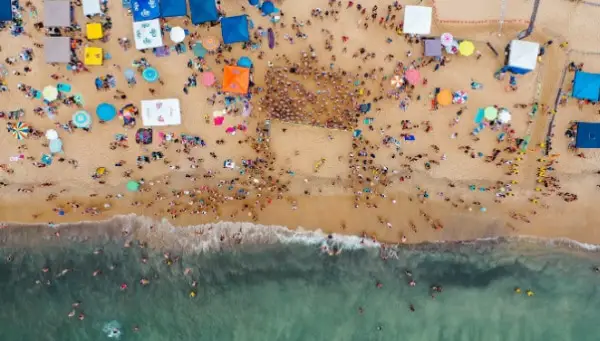
Maybe, like myself, you are excited to go to a concert or any other place that might have a large crowd, but would you be able to fly a drone over the crowd? I’ve done my research and here is what I discovered.
According to the FAA, both recreational pilots and commercial pilots are not allowed to fly drones directly over people unless they are participating in the activity. However, the FAA now allows for the Part 107 licensed pilots to apply for a waiver that could allow pilots to fly over people.
Keep reading to find out more about flying over people and new laws that will allow this to happen.
Can I Fly My Drone Over People?
Drones are flying mechanical devices, and because of this, they would do quite some damage if you were to fly into someone.
The FAA is in charge of regulating the Airspace above the entirety of the United States of America, and they have deemed it dangerous for these remotely piloted machines to fly over people.
On the FAA website, they clearly state that recreational pilots are not allowed to fly over ANY person or moving vehicles that aren’t involved in the activity. This includes flying over a busy street packed with cars. If there’s a chance you’ll fly over a car, then don’t take the risk.
You are, however, allowed to fly your drone over people who are directly participating in the flight. These people may be your family, or crew members of a specific shoot, and of course yourself.
Basically the people you are allowed to fly over would have given you consent to fly over them, and thus if something were to happen, they would have given you prior permission to fly over them.
Are You Allowed To Fly Over People With a Part 107 License?
The FAA now allows for licensed pilots under Part 107 to request for a waiver to be able to fly over people.
This is known as the Part 107.39 waiver. Many people complain about this because the FAA actually gives very little guidance on how to obtain this waiver and also have denied many pilots who have requested the waiver.
The 107.39 waiver to fly over people is the second most requested waiver behind the night waiver.
It may be hard to get but this, but the waiver is not impossible to get! Once you get permission to fly a drone over people you will be free to film some pretty amazing stuff.
I would have loved to talk about this section and add in recreational pilots as well, but sadly if you want to ever be able to fly over people with a drone, you need to get yourself a Part 107 droning license.
As I mentioned above, Part 107 pilots have the ability to apply for waivers that allow them to ignore some of the FAA’s rules and regulations for a certain amount of time.
This is a big reason why a lot of droning enthusiasts end up getting their Part 107 licenses. When it comes to flights over people, first of all, you will always require a Part 107 remote pilot certificate that will always be required.
Can I Fly Over Vehicles? (Stationary & Moving)
The FAA states that along with flight over people, flight over moving vehicles is not allowed. However, this means that when a vehicle is stationary, pilots are then allowed to fly over the vehicle.
It doesn’t matter if the vehicle has people in it or not, as long as the vehicle is stationary, you are allowed to fly over it.
This is allowed because the FAA believes that there should be enough cover over a person’s head when sitting in a stationary vehicle. Whereas if they were standing outside the car, there would be no protection over that person.
And when it comes to moving vehicles, the flight is not allowed even though they still have the same type of protection as the stationary vehicle, but the laws of physics then come in to play.
The driver and the drone would then be moving at high velocities which would make the impact of the drone on the car far greater.
This is the main reason why the FAA allows drones to be flown over stationary vehicles with people in them, but do not allow for drones to be flown over highways with moving vehicles.
Potential New Laws For Flying a Drone Over People As Licensed Drone Pilot (Part 107 license)
The FAA is constantly working on ways to make the skies safer for everyone. While they are making the skies safer they are also working on ways that will not ruin the hobby for drone pilots.
The secretary of transportation put out a proposal back in January 2019 that basically raised a lot of questions for drone pilots.
But, this is what the proposal said about drone flight over people!
Flying over people is divided into three different categories. These categories (except for the first one) are not based on weight but actually based on the risk to human life.
Category 01:
The first category applies to any drone weighing under 0.55 pounds. The rule here is that there is no rule!
As long as you have your Part 107 license then you are free to fly as you please. You have complete freedom, there are no restrictions for drones weighing under 0.55 pounds.
Category 02:
This category is where it gets a little tricky. With category 2, the rules are not just based on weight, but based on how many injuries the drone would cause if it were to strike someone.
If your drone had to fall out of the sky and hit someone, that force needs to be equal to if they were hit by 11 foot-pounds of force from a rigid object.
Now I don’t know what this equates to exactly, but a study of 12 karate black belts showed punches delivered an average of 325 foot-pounds of force.
So this leaves it up to the manufacturers to design their drones in a way that would keep them under that 11 foot-pounds of force. This doesn’t tell any manufacturer how to get to this end goal, instead, it gives them a goal and it is up to them to make sure they get there.
Category 2 also says that the aircraft which is the drone must not have any exposed rotating parts that could potentially cut skin. And, as it stands right now, this eliminates a huge majority of drones on the market right now.
Which then opens up the question, will our drones need to come with prop guards from now on?
And lastly, the drone that will be operated over people must not have any FAA identified safety defects.
Category 03:
Category 3 is basically the same as Category 2, except for a slight change.
With Category 3 the threshold of injury is raised to 25 foot-pounds of force.
What they also did for this category is to limit exposure to people through compliance with operational limitations.
Now that might sound confusing, but basically drones that fall under this category will have certain limitations.
The limitations are:
- These drones will not be allowed to fly over places like open-aired assemblies(events like concerts).
- If a drone falling under this category is flying, then the flight needs to be within a restricted access area. If anyone is going to enter into this restricted area, then they need to be well-informed that there will be a drone flying over them.
- If the drone is not flown in restricted access or closed area, then it may transit or fly over a crowd but not hover over people.
This drone is still required not to have any exposed parts that could lacerate or cut skin.
Now, these rules also require any remote pilot certificate holder to show their certificate to any law enforcement officer if requested to show it.
